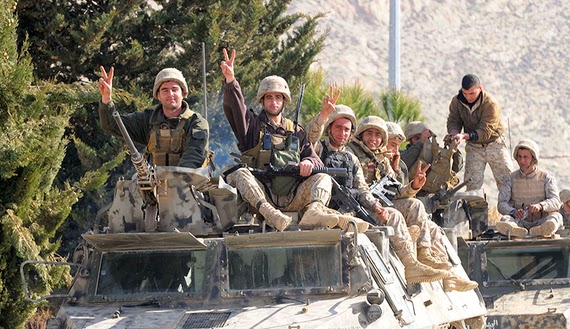Dawn on Jan. 22 brought both the terrorist attack and the army’s dredges. Clashes broke out, and the army shelled the terrorist positions and launched airstrikes from helicopters. After around 72 hours, the attackers withdrew, leaving behind 35 dead, according to the same military source. The army announced the death of five soldiers in its ranks.
A government source following up on the ongoing confrontations between the Lebanese army and Jabhat al-Nusra told Al-Monitor on condition of anonymity that the issue requires radical action. It cannot be left to proceed as it is. In general, no army can engage in a war of attrition with any militia. The balance of power is not reassuring.
The terrorists, divided between the Islamic State (IS) and Jabhat al-Nusra and deployed along the northeastern border of Lebanon, can mobilize thousands of armed men who are ready to die.
The government source stated that he had official information confirming that on Jan. 23, contact was lost with three of the army’s soldiers who fell during the recent clashes.
The army found their bodies the next morning, after it forced Jabhat al-Nusra to withdraw and increased its presence in the region. The soldiers had been shot in the back, meaning that the terrorists intentionally killed them and left them to be found. This made the army more alert and cautious, and it soon discovered that the three bodies had been planted with bombs that would detonate when they were moved. The Lebanese army is up against terrorists who are acting without any legal or humanitarian restraints.
The Lebanese army cannot become mired in a permanent war of attrition, leaving it with few options:
- The army withdraws from the confrontation, just like the Syrian army did in some places, such as Nabak region, two years ago. This option is also bad for the whole Lebanese nation, as Lebanon’s geography is quite different from Syria’s. Syria’s surface area is 18 times larger, which allowed the Syrian army to tactically withdraw from the field and attack other areas later without great damage. Lebanon, however, is smaller and does not leave room for such options. The current battle lines are no more than 20 kilometers (12 miles) from the international Beirut-Damascus road in some places and come uncomfortably near the northern Lebanese coast and the major residential areas in the Bekaa Valley, such as mostly Christian Zahle. Consequently, if the Lebanese army retreats from any defensive line, it risks a humanitarian and military catastrophe going deeper than those in western Iraq. Such a choice is out of the question, as it would mean the end of the Lebanese state.
- A destructive battle is waged against the terrorists in their known hotbeds along the Lebanese-Syrian border. The same governmental source asserted that military experts consider such a battle possible. However, it would necessitate cooperation between three forces: the Lebanese army, Hezbollah militants and the Syrian army for complete operational coordination. This would help to tighten the noose. But the Lebanese officials are hesitating to make this decision, not wanting to coordinate with the Syrian army, as some of them are opposed to the Syrian regime and support its opponents.
The Lebanese army remains torn between a suicidal withdrawal and a forbidden attack, with only one choice left — to continue to be drained by the terrorists. This option is not only costly, but does not constitute a solution and cannot go on endlessly.
Source: Al Monitor



